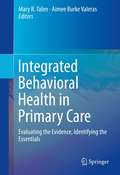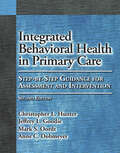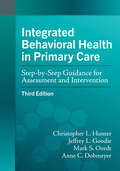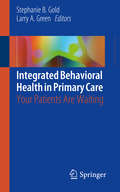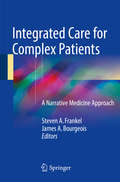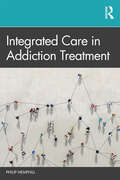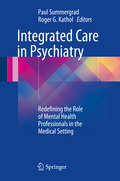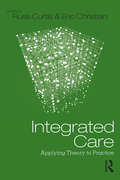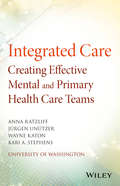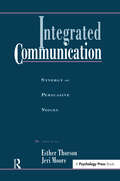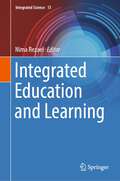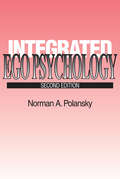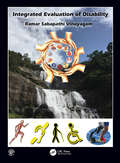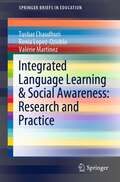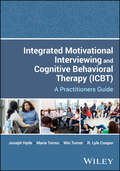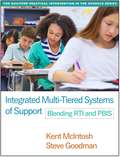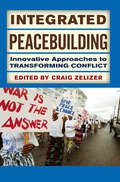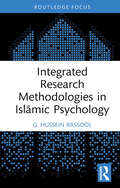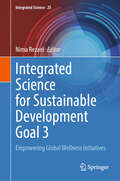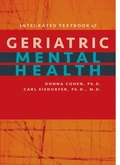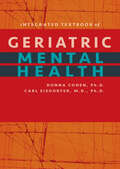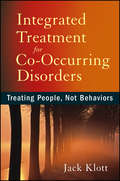- Table View
- List View
Integrated Behavioral Health in Primary Care
by Aimee Burke Valeras Mary R. TalenContributed by experts who've developed integrative healthcare initiatives with strengths in the areas of policy and principles, organizational systems, or clinical practice. These contributors will illustrate the concepts and describe the nuts and bolts of their integration initiatives. In the conclusion of each section, the editors will construct a template to systematically evaluate these essential elements. This template will organize the information to help stakeholders compare and contrast the strengths, resources, limitations, and challenges of how each model meets the vision of integrative healthcare. In the concluding section the information in the preceding sections connects to provide a coherent synopsis of the common themes and practices, from the macro to micro levels of care, which foster successful integration of the medical and psychosocial systems.
Integrated Behavioral Health in Primary Care: Step-By-Step Guidance for Assessment and Intervention
by Christopher L. Hunter Dr. Jeffrey L. Goodie Mark S. Oordt Anne C. DobmeyerThis timely new edition of Integrated Behavioral Health in Primary Care brings the reader up to speed with the changing aspects of primary care service delivery in response to the Patient-Centered Medical Home (PCMH), the Triple-Aim health approach, and the Patient Protection and Affordable Care Act. Drawing on research evidence and years of experience, the authors provide practical information and guidance for behavioral health care practitioners who wish to work more effectively in the fast-paced setting of primary care, and provide detailed advice for addressing common health problems such as generalized anxiety disorder, depression, weight issues, sleep problems, cardiovascular disorders, pain disorders, sexual problems, and more. New to this edition are chapters on population health and the PCMH; children, adolescents, and parenting; couples; managing suicide risk; and shared medical appointments.
Integrated Behavioral Health in Primary Care: Step-by-Step Guidance for Assessment and Intervention
by Christopher L. Hunter Dr. Jeffrey L. Goodie Mark S. Oordt Anne C. DobmeyerNow in its third edition, Integrated Behavioral Health in Primary Care details the relevant updates in the field for behavioral health care practitioners and offers targeted clinical assessment and intervention strategies that will meet the future needs of educators, students, and clinicians. Drawing on comprehensive research evidence and the authors&’ decades of clinical experience, this book offers practical guidance for behavioral health care practitioners who want to work more effectively in the fast-paced and complex setting of primary care. Chapters provide an overview of the key foundational concepts and applications of behavioral health within the primary care setting, and detail the competencies required for optimal assessment and intervention outcomes. The authors give detailed, practical advice for addressing common behavioral health concerns including depression, anxiety, health behaviors, pain disorders, substance misuse, and other pertinent problems, as well as special issues such as managing suicidal risk. Key updates to this third edition include: An expanded exploration of core competencies and clinical practice management skills; A review of the neuromatrix theory of pain model, as well as additional important considerations for assessing and treating fibromyalgia and other pain disorders, and; Assessment and intervention guidelines for opioid misuse.
Integrated Behavioral Health in Primary Care: Your Patients Are Waiting
by Stephanie B. Gold Larry A. GreenThis book provides an evidence-based guide for primary care physicians seeking to integrate behavioral health into their practice. This is grounded in the underlying notion that integrating behavioral health and primary care is not an adjustment to practice but a reconstruction of how primary health care is defined and delivered. While some aspects (billing and financing) will be specific to the policy context in the United States, much of the book will contain universal lessons for an approach to integration from a primary care perspective that may be relevant across the globe. This guide is organized to follow a comprehensive approach, derived from lessons learned by early adopters of integration. Dividing the book in this manner creates a unique and natural flow from the “why” of integrating care to a step-by-step approach to achieve integration in a practice. The book includes the case for why integrating behavioral health is important; what integration looks like in practice; and how to transform a practice and grow a team of clinicians to work together to address mental, emotional, and behavioral problems. Each chapter starts with a short preamble to introduce the stage of integration. Each chapter and subchapter would end with a summary box of key messages and a short list of resources (articles, websites, etc) for further information for each topic. Where relevant, chapters additionally include a brief section on application for specific populations (pediatrics, geriatrics, etc). This is an ideal guide for primary care physicians and their medical and administrative teams interested in integrating behavioral health in their practice.
Integrated Care for Complex Patients: A Narrative Medicine Approach
by Steven A. Frankel James A. BourgeoisThis book presents case-based descriptions of models for the inclusive, multispecialty and multidisciplinary clinical care of complex cases. Cases range from primary care patients with complex systemic medical and psychiatric comorbidity, to those requiring specialty care, to those with potentially terminal illnesses. While each category and case has its unique requirements often necessitating different models of care, the commonalities in approaching complex clinical situations is underscored. Extended case narratives written by the treating physicians, summarizing both the course of clinical care and physicians' reflections on the challenges of managing complex patients, comprise the bulk of the book. Five additional chapters on systems issues associated with care of complex patients, together with a chapter on end of life considerations, a narrative analysis of the physicians reflections about complex patients, and a concluding chapter are prominently included to anchor the case narratives. Written by experts in the field, these descriptions form unique models for assessing and treating complex cases. Integrated Care for Complex Patients is a useful guide for all health practitioners and health administrators who are responsible for clinically complex cases, including physicians in primary care and psychiatry, physician assistants and nurse practitioners, and psychologists.
Integrated Care in Addiction Treatment
by Philip HemphillThis book emphasizes the importance of integrative care among the healthcare professionals involved in addiction treatment and includes a plan for executing and assessing the success of the system. Drawing on three decades of experience helping practitioners, managers, administrators, and funders understand and implement this treatment, Dr. Hemphill discusses the history and integration of coordinated care, and details how it works in practice from the medical and business perspectives. He outlines a model that encourages the expansion of detection systems and stresses the importance of behavioral health treatment in addiction treatment centers, which can reduce treatment costs and enhance care management. Resources are included for assessing organizational readiness, monitoring outcomes, and suggestions for continuous improvement to ensure a seamless transition, leading to better outcomes, patient engagement, and worker job satisfaction. This book offers innovative solutions that any healthcare professional practicing behavioral health and addiction medicine can utilize to ensure optimal care.
Integrated Care in Psychiatry
by Paul Summergrad Roger G. KatholIntegrated Care in Psychiatry: Redefining the Role of Mental Health Professionals in the Medical Setting is a landmark title in the field, offering a clear, detailed, and cohesive call by leading experts for coordinated care for patients with concurrent psychiatric and medical conditions. The renowned editors and authors argue that what is slowly occurring, and greatly needed at a faster pace, is nothing less than a sea change in the way that psychiatric care will be delivered. The current, mostly segregated, medical and psychiatric model of care has led to the development of competing medical and psychiatric subcultures that have resulted in a lack of dialog among health providers, administrators, and payers - and thus in less than optimal patient outcomes. To remedy this problem, the book offers a practical, insightful road map to achieving the central tenet of health reform - truly coordinated, patient-centered care where the care experience for the patient, the medical care itself, and the cost outcomes improve as the system changes from fee-for-service to population-based health. An invaluable reference for all clinicians, policy makers, payers, administrators, and others interested in the debate surrounding healthcare systems, Integrated Care in Psychiatry: Redefining the Role of Mental Health Professionals in the Medical Setting is a major contribution to the literature and a gold standard resource.
Integrated Care: Applying Theory to Practice
by Russ Curtis Eric ChristianThis book provides pertinent and practical information about how to create, work, and thrive in an Integrated Care (IC) setting. Unlike other books on the subject, it focuses on the "nuts and bolts" of establishing an IC practice; it also covers material that is often missing from or insufficiently covered in the existing literature. Specific topics discussed include the basics of IC, such as different models and levels of IC and examples of IC initiatives; how to build an IC program, with guidelines for entering and working effectively in a practice, as well as managing the associated economic aspects; ethical issues involved in IC, given the discrepancies between medical and mental health ethical standards; assessment and intervention in IC; cross-cultural and diversity issues in IC; and leadership, consultation, and supervision.
Integrated Care: Creating Effective Mental and Primary Health Care Teams
by Jürgen Unützer Wayne Katon Anna Ratzliff Kari A. StephensAn integrated, collaborative model for more comprehensive patient care Creating Effective Mental and Primary Health Care Teams provides the practical information, skills, and clinical approaches needed to implement an integrated collaborative care program and support the members of the care team as they learn this new, evidence-based, legislatively mandated care delivery system. Unique in presenting information specifically designed to be used in an integrated, collaborative care workflow, this book provides specific guidance for each member of the team. Care managers, consulting psychiatrists, primary care providers, and administrators alike can finally get on the same page in regard to patient care by referring to the same resource and employing a common framework. Written by recognized experts with broad research, clinical, implementation, and training experience, this book provides a complete solution to the problem of fragmented care. Escalating costs and federal legislation expanding access to healthcare are forcing the industry to transition to a new model of health care delivery. This book provides guidance on navigating the changes as a team to provide the best possible patient care. Integrate physical and behavioral care Use evidence-based treatments for both Exploit leading-edge technology for patient management Support each member of the collaborative care team Strong evidence has demonstrated the efficacy of a collaborative care approach for delivering mental health care to patients in a primary care setting. The field is rapidly growing, but few resources are available and working models are limited. This book provides a roadmap for transitioning from traditional methods of health care to the new integrated model. Providers ready to move to the next level of care will find Creating Effective Mental and Primary Health Care Teams an invaluable resource.
Integrated Communication: Synergy of Persuasive Voices
by Esther Thorson Jeri MooreBuilding brands through integrated marketing is an approach being used by all top-level marketing strategists. The result of a series of papers presented at the eleventh annual Advertising and Consumer Psychology Conference held in Chicago, this volume brings together researchers and professionals whose efforts focus on integrating the various persuasive tools of marketing. It goes beyond case studies of the use of integrated marketing to look at how integrated communication actually works on achieving optimal effects on the various audiences for products.
Integrated Education and Learning (Integrated Science #13)
by Nima RezaeiIntegrated Education and Learning aims to discuss novel approaches to offer integrated educational methods. Within the last few years, educational techniques have evolved to favour critical thinking and improve learning skills. This volume links thinking and learning in educational settings and discusses diverse mechanisms that influence this association; including meta-cognitive capacity, memory, cognitive style, conceptual approaches, digitalization, teaching approaches, echoing, and questioning. It embraces this discussion at all levels, from early childhood education to higher education. This book also includes teaching tips for creating a learning environment that cultivates students’ creativity and critical thinking on both online platforms and live-in-classroom. The book follows discussing the merits of an integrated educational paradigm that will help develop highly intellectual thinkers and will promote modern values to face current and future challenges. Finally, the book shows a balance between learning and education to enhance creativity, critical thinking and social skills.
Integrated Ego Psychology
by Norman A. FolanskyEgo psychology is the aspect of psychoanalytic theory concerned with how people adapt to the demands and possibilities of their worlds in accordance with their inner requirements. All substantial theories of personality refer to adaptation, but there are several features special to ego psychology. It offers by far the most elaborate picture of the adaptive apparatus and of the varied devices humans have for negotiating among their drives and their life situations. More than any other theory of psychology, it emphasizes the complicated transactions that go on in people's minds, of which many are outside conscious awareness. Norman A. Polansky argues that we must be disciplined enough to commit ourselves to one consistent line of theory if we are to harness reasoning to go beyond what we can directly observe.Few who are, or aspire to be, caseworkers, therapists or counselors come to this book innocent of all the ideas contained herein. Much will seem familiar from previous training and from experiences with people. Moreover, many Freudian terms have been adopted into the working vocabularies of all educated people. Words like instinctual drive, defense mechanism, anxiety, guilt, conflict, unconscious, and the like, are used all the time in estimating each other. One task of Integrated Ego Psychology is defining such terms with precise meanings, as well as showing the logical connections among them.Psychoanalytic theory has envolved for about a century, and some "grand simplicities" have finally emerged. This book, for practitioners, indicates the need for a theory to guide work if we are to help people effectively. The theory must be elaborate enough to cover a very wide range of human activity and it must meet certain other standards as well.
Integrated Evaluation of Disability
by Ramar Sabapathi VinayagamThere are overwhelming demands for health and rehabilitation services due to rise in the number of disabled people. The existing literature on disability evaluation has only focused on impairment or functional limitation or earning capacity. They have not considered the skills fundamental to live, learn and work successfully in the community. This book addresses integrated evaluation of disability using ‘Clinical Tools’, ‘Activity Participation Skills Assessment Scale’, ‘Personal Factors Measurement Scale’, and ‘Environmental Factors Measurement Scale’. Physicians from all disciplines can use this method to evaluate disability pertaining to their respective fields. Key Features Applies the principles of ‘World Health Organization’s International Classification of Functioning, Disability and Health - ICF’ Includes case studies in the hypothetical model in this book Includes a Ready Reckoner Impairment Table provides impairment score for 120 common clinical conditions Consists of an integrated software which computes percentage of disability for clinical conditions
Integrated Experiential Coaching: Becoming an Executive Coach (The\professional Coaching Ser.)
by Lloyd Chapman'Coaching is growing across the globe as a viable and useful intervention to help executives deal with the complexity they face day-to-day. In response to this increased demand, many coaches have presented their "model" of coaching to the world of business, and a number of these have made it into print. Few are based on a rigorous development process or have provided the reader with an insight into their development. The Author wanted to offer to the readers of our professional coaching series the opportunity to engage with a practitioner who had been through a journey of learning built on their experience, the literature and research. This book meets the need identified for a clear and rigorous account by an experienced coach of the development of their model within the scientist-practitioner framework.
Integrated Language Learning & Social Awareness: Research and Practice (SpringerBriefs in Education)
by Tushar Chaudhuri Renia Lopez-Ozieblo Valérie MartinezThis book reports on and analyses the Integrated Language Learning & Social Awareness Project, a unique project in the field of Foreign Language Learning and Telecollaboration till now in the world. It takes the existing research on telecollaborative learning, content and language integrated learning and e-learning and combines them into one coherent concept in which language acquisition and enhancement takes place through task-led research on the specific issue of “Healthy Cities” by targeting language learners from around the world. The book delivers insights into the planning and the development of the project including collaborative task design and its underlying theoretical and research frameworks. It then goes on to reflect on how these underlying frameworks are developed further to broaden the existing paradigms of research in the field of telecollaborative language learning.
Integrated Modular Treatment for Borderline Personality Disorder
by Livesley W. JohnThis clinical guide describes a different way to treat borderline personality disorder. Rather than using the currently available therapies, the author presents a trans-theoretical approach that combines the essential elements of all effective treatments. The book offers a framework for understanding the nature and origins of borderline personality disorder that is used to define treatment targets and strategies. Building on this foundation, systems for organizing treatment are presented around change mechanisms common to all effective therapies. Interventions are presented in modules, allowing therapists to select treatment according to the needs of patients. Treatment is explained by dividing therapy into phases, each addressing different problems. Methods are described to promote engagement, manage suicidality, treat crises, improve emotional regulation, restructure maladaptive interpersonal behaviours, construct a new sense of self and identity, and build a life worth living. The volume will interest mental health professionals from all disciplines and different levels of expertise.
Integrated Motivational Interviewing and Cognitive Behavioral Therapy (ICBT): A Practitioners Guide
by Maria Torres Win Turner Joseph Hyde R. Lyle CooperA practical approach to clinical interventions applicable to a range of mental health diagnoses Integrated Motivational Interviewing and Cognitive Behavioral Therapy (ICBT) for Adults is a guide for practitioners looking for evidence-based clinical interventions that are portable across settings and diagnoses. Written in plain English and with an emphasis on step-by-step instructions, this valuable toolkit collects strategies and interventions that have been shown to be effective in substance use disorder, depression, anxiety, and beyond. This widely applicable treatment approach draws on motivational interviewing, cognitive behavioral therapy (CBT), motivational enhancement therapy, mindfulness, functional analysis, and other methods that are strongly supported in the literature. With content reflecting emerging research findings and evolving social contexts, this book is both timely and firmly rooted in science. After presenting a set of proven techniques for motivational interviewing and CBT, this book details a 16-session course designed to fit within conventional models of therapeutic practice. Each session covers a cognitive behavioral skill (e.g., assertiveness, handling cravings, suicidality) and builds upon the previous sessions, but they also work as standalone interventions and do not have to be followed in a particular order. The book also offers additional tools to promote intervention quality and clinical supervision. Worksheets, handouts, and other materials are included in photocopiable format, making this a valuable guide in all outpatient mental health settings. Learn the fundamentals of motivational interviewing, cognitive behavioral therapy, and other evidence-based treatment modalities Get practical clinical tools, including step-by-step session guides on cognitive behavioral skills relevant to a range of diagnoses Access self-assessments, clinical supervision tools, and other resources to enhance clinical effectiveness Incorporate emerging research, changing social contexts, and lessons learned from the COVID-19 pandemic into your practice Earlier editions of this guide focused on addressing substance use disorders and cooccurring disorders. This edition is applicable to those disorders but reflects that these clinical strategies are transdiagnostic.
Integrated Multi-Tiered Systems Of Support: Blending Rti And Pbis (The Guilford Practical Intervention In The Schools)
by Steve Goodman Kent McIntoshMany schools have implemented academic response to intervention (RTI) and schoolwide positive behavioral interventions and supports (PBIS) as separate initiatives. This book provides keys to making these programs more effective, seamless, efficient, and sustainable by combining them into a single multi-tiered system of support (MTSS). Steps and strategies are outlined for integrating data structures, practices, teams, and district systems. Contributing authors present detailed case examples of successful MTSS implementation in three states. In a large-size format with lay-flat binding, the book features 27 reproducible checklists and evaluation tools. Purchasers get access to a companion website where they can download and print the reproducible materials plus other helpful resources. <p><p> This book is in The Guilford Practical Intervention in the Schools Series, edited by T. Chris Riley-Tillman.
Integrated Peacebuilding
by Craig ZelizerIntegrated Peacebuilding addresses the importance of weaving peacebuilding methods into diverse sectors including development, humanitarian assistance, gender, business, media, health, and the environment--areas where such work is needed the most. Incorporating peacebuilding approaches in these fields is critical for transforming today's protracted conflicts into tomorrow's sustainable peace. Covering both theory and practice, Dr. Zelizer and his team of leading academics and practitioners present original essays discussing the infrastructure of the peacebuilding field--outlining key actors, donors, and underlying motivations--as well as the ethical dilemmas created by modern conflict. Exploring both the challenges and lessons to be found in this emerging field, Integrated Peacebuilding is perfect for courses on peacebuilding, conflict resolution, international development, and related fields.
Integrated Research Methodologies in Islāmic Psychology (Islamic Psychology and Psychotherapy)
by G. Hussein RassoolThis book provides a foundation of the methodology of research scholarship in Islāmic studies, psychology and psychotherapy, offering an understanding of the concepts and techniques of Islāmic research methodology integrated with qualitative and quantitative research. Integrating Islāmic moral and epistemological values into research methodologies, the text synthesises research methodologies and approaches (empirical, rational) with Islāmic research scholarship. Chapters include a range of topics including research ethics from an Islamic perspective, systematic methodology of research in Islamic studies and social sciences and inductive and deductive approaches. Other questions covered include how to integrate the Qur’ân and Hadith (rules, concepts and statements) with psychological phenomena and how to write a research proposal and research paper. Each chapter includes rich case examples and relevant practical examples. This book is ideal for researchers and students in Islāmic psychology and psychotherapy wishing to learn more about the techniques and principles of Islāmic research scholarship in the field.
Integrated Research Methodologies in Islāmic Psychology (Islamic Psychology and Psychotherapy)
by G. Hussein RassoolThis book provides a foundation of the methodology of research scholarship in Islāmic studies, psychology and psychotherapy, offering an understanding of the concepts and techniques of Islāmic research methodology integrated with qualitative and quantitative research.Integrating Islāmic moral and epistemological values into research methodologies, the text synthesises research methodologies and approaches (empirical, rational) with Islāmic research scholarship. Chapters include a range of topics including research ethics from an Islamic perspective, systematic methodology of research in Islamic studies and social sciences and inductive and deductive approaches. Other questions covered include how to integrate the Qur’ân and Hadith (rules, concepts and statements) with psychological phenomena and how to write a research proposal and research paper. Each chapter includes rich case examples and relevant practical examples.This book is ideal for researchers and students in Islāmic psychology and psychotherapy wishing to learn more about the techniques and principles of Islāmic research scholarship in the field.
Integrated Science for Sustainable Development Goal 3: Empowering Global Wellness Initiatives (Integrated Science #25)
by Nima RezaeiThis contributed volume offers and interdisciplinary view on several topics related to related to the Sustainable Development Goal 3 (SDG 3). These targets mainly involve reducing maternal mortality, ending preventable deaths under five years of age, fighting communicable diseases, e.g., tuberculosis, HIV, malaria, hepatitis B, and neglected tropical diseases, reducing mortality from non-communicable diseases, e.g., cardiovascular disease, cancer, diabetes, chronic respiratory disease, and suicide, and promoting mental health, prevention and treatment of substance abuse, reducing road injuries and deaths, universal access to sexual and reproductive care, family planning and education, achieving universal health coverage, reducing illnesses and deaths from hazardous chemicals and pollution, implementation of the who framework convention on tobacco control, supporting research, development and universal access to affordable vaccines and medicines, increasing health financing and supporting health workforce in developing countries, improving early warning systems for global health risks.
Integrated Textbook of Geriatric Mental Health
by Donna Cohen Carl Eisdorfer<p>As the population ages, increasing numbers of older people require the attention and services of mental health professionals. Despite their prevalence, however, mental health problems in this population often go undiagnosed and therefore untreated. This textbook offers medical students and professionals the information they need to care for older people with mental disorders. <p>Drs. Donna Cohen and Carl Eisdorfer, two internationally recognized experts in geriatric mental health, provide a comprehensive framework within which students and practitioners alike can address the salient issues of the field. These include the biopsychosocial aging processes, specific pathologies prevalent in later life, social issues common to the elderly, the delivery of care in various settings, and the economic policies affecting services for older people. <p>The authors’ goal is not only to enhance clinical practice but also to urge physicians to develop and coordinate a more holistic care strategy that acknowledges the complex challenges of older patients. To this end, Cohen and Eisdorfer discuss essential principles of optimal care, the latest research findings, evidence- and consensus-based practice standards, resources to help professionals keep abreast of the changing mental health landscape, and ethical dilemmas of clinical practice and research. <p>The signal strength of this book lies in its integrated approach, an approach that emphasizes the philosophy and principles of caring for older people along with clinical practices and issues. From this broader perspective, the authors describe the many factors that influence the lives, health, and well-being of older patients and their caregivers, making this an ideal text for psychiatrists, psychologists, nurses, and social workers.</p>
Integrated Textbook of Geriatric Mental Health
by Donna Cohen Carl EisdorferAs the population ages, increasing numbers of older people require the attention and services of mental health professionals. Despite their prevalence, however, mental health problems in this population often go undiagnosed and therefore untreated. This textbook offers medical students and professionals the information they need to care for older people with mental disorders.Drs. Donna Cohen and Carl Eisdorfer, two internationally recognized experts in geriatric mental health, provide a comprehensive framework within which students and practitioners alike can address the salient issues of the field. These include the biopsychosocial aging processes, specific pathologies prevalent in later life, social issues common to the elderly, the delivery of care in various settings, and the economic policies affecting services for older people. The authors’ goal is not only to enhance clinical practice but also to urge physicians to develop and coordinate a more holistic care strategy that acknowledges the complex challenges of older patients. To this end, Cohen and Eisdorfer discuss essential principles of optimal care, the latest research findings, evidence- and consensus-based practice standards, resources to help professionals keep abreast of the changing mental health landscape, and ethical dilemmas of clinical practice and research. The signal strength of this book lies in its integrated approach, an approach that emphasizes the philosophy and principles of caring for older people along with clinical practices and issues. From this broader perspective, the authors describe the many factors that influence the lives, health, and well-being of older patients and their caregivers, making this an ideal text for psychiatrists, psychologists, nurses, and social workers.
Integrated Treatment for Co-Occurring Disorders
by Jack KlottThe definitive guide to identify, assess, and create individualized treatment plans for high-risk clients who suffer from challenging co-occurring disorders"Treat the person and not the diagnosis. Respect that all behaviors are purposeful. Remain mindful that nobody changes behaviors without motivation. These essential guiding principles are the framework of this book. They will be repeated quite often as we examine the challenging population of men and women with co-occurring disorders." -From Integrated Treatment for Co-Occurring DisordersAnnual studies reveal that 70 percent of men and women who died by suicide were diagnosed with a mental illness or personality disorder and used drugs to gain temporary relief from the symptoms. Until now, very little has been written about how to identify, assess, and treat this population. Integrated Treatment for Co-Occurring Disorders: Treating People, Not Behaviors addresses that need.Respectful of the client and filled with practical advice, this book:Examines the guiding principles for treating clients with co-occurring disordersDetails the methods of formulating an evidence-based individualized treatment plan for the self-medicating mentally illExplores how to assess this population for suicide risk and vulnerabilityFocuses on the person and not a behaviorally defined diagnostic categoryReflects state-of-the-art knowledge for the treatment of co-occurring disordersIllustrates how Motivational Enhancement Therapy can be an effective treatment strategyWith numerous clinical case studies to illustrate key points and reinforce learning, Integrated Treatment for Co-Occurring Disorders encourages a flexible, person-centered treatment approach that focuses on the individual rather than the diagnosis.
